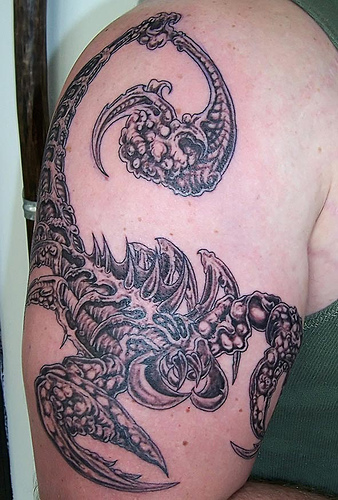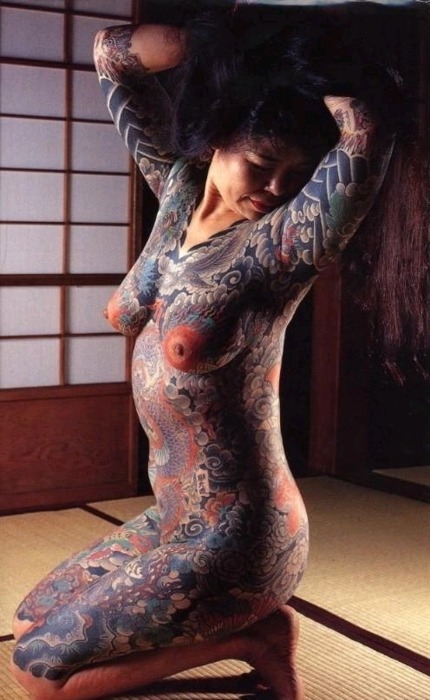For centuries, tattoos symbolized the membership in groups, families, but for a few years, tattoos have become more popular. It is possible that many people have them not only for decorative purpose, so we must understand why more than thirty million people worldwide have submitted this type of self mutilation. The choice of a tattoo today can tell something about the soul of its owner; some believe that a tattoo is the graffiti for the soul...
We'll find many surprising stories about the tattoos significance and role: many sailors believe that a tattoo is a talisman against the possibility of drowning at sea. The American Indian believed tattoos protected them in battle and some Burmese people think even today that a tattoo over the heart can stop bullets.
The tribal tattoos history is a real kaleidoscope; each place of Earth where the tattoos are popular has a particular and many times surprising history, significance, tradition, and realization technique. But almost everywhere, the tattoos appeared a few hundred years ago.
The place where the word tattoo originated, were the tribal tattoo reached perfection for thousand of years is Tahiti. Here the tattoos applications are most painful, but it reached a high level of artistic endeavor. The habitants of Samoa still believe that the elaborate geometrical design of the traditional body suit is the way to show respect for the God-qualities, for others it is the rite of passage to manhood.
The ancient Maori warriors started their tattoos tradition painting their faces with charcoal before each battle. Then they began to make the design permanent, calling it "moko". It was said that a man without "moko" was a "papatea" (plain face) and was considered an outcast.
Celtic tattoos are one of the most attractive design choices. The design comes from ancient art from Ireland, Scotland and England. They are as old as the Celtic history is.
Some fifth century painted pictures are representing warriors having tattoos all over their body; the tattoos are indicating the rank or caste. Later they were also symbols of religious devotion, simply for decoration or appeal for fertility.
Celtic tattoos are not duplicating real things, they are made of sinuous lines interweaving to complete a cycle. Almost all the Celtic tattoo designs are complicated, there is neither end nor beginning to it. There are many intricate patterns too...
Celtic animal designs are unending, but some have the cords terminate in feet, heads, or tails. Many designs are presenting zoomorphic elements or spirals.
Tattoos are also largely considered the mark of the Yazuka - the Japanese Mafia. A full body tattoo can take many years to be made and costs about $50000; the tattoo complicated colored design seems to have mythic power and only some specialized masters can accomplish such a miraculous work of art.
In China the tattoos are made with designs of 2500 years old, and are representing a variety of fantastic beasts: fish, deer, dragoon. There are made for personal protection and like emblems of noble birth. Siberian tribesmen still ink symbols down their spine to cure the back pain.
In Russia, the tattoos tradition isn't so old: they were the prisoners' secret language. In Stalin's gulags, tattoos were a form of protest; today they are only a fancy accessory.
Borneo is an exotic and hard to reach place where tattoos ward off harm and disease. In the "heart of darkness" tattoos as protection gains some credibility.
Hawaii is home for some famous tattooist, like Norman Keith. He is well known "for giving the modern tattoo revolution a major boost." He began moving American tattooing towards more Japanese style, unified, custom design. He also changed the status of tattooists, bringing them out of the underground to the growing light of the artistic respectability.
In St. Lawrence Island the Asiatic Eskimo tribesmen can live past 100 and have, certainly, the last most authentic tattoos on this planet.
We can find spectacular tribal tattoos even in Queen Charlotte Islands, where the images are family history told in pictures. Animals' designs on the hands are announcing the family name.
In Mackenzie Delta small crosses on the cheeks or shoulders are keeping a tally of the taken whales. Netsilik women were tattooed in order to gain admittance to the afterworld.
In the northern Kalinga (Philippines) the tribesmen are the most ornamented people of the region; their body art is resurrected one more time.
Now let see the tribal tattoo tradition in US. Since the 18th century, merchant sailors acquired tribal skin art returning from voyages in the South Seas. Because members of the British aristocracy traditionally took to the sea, and returned with tattoos (discreetly hidden) some western tattooist set up shop near the docks. The tattoos become exotica for the upper classes. Later, the port city tattooist began inking criminals, fiefs and prostitutes and tattoo became mark of lowlifes. This is the reason way for hundred of years the tattoo remained underground. The tattooist was considered as an outlaw and the tattoo was imprisoned by persecutions and prohibitions born of myriad fears.
Now the tattoos are made using modern and secure devices, capable of 125 pricks per second. The designs are presented worldwide using the most spectacular advertising tools.
Whether it is on an arm or ankle, a butterfly or tribal symbol, a piece of body art no longer holds the lure of rebellion it once did...
We'll find many surprising stories about the tattoos significance and role: many sailors believe that a tattoo is a talisman against the possibility of drowning at sea. The American Indian believed tattoos protected them in battle and some Burmese people think even today that a tattoo over the heart can stop bullets.
The tribal tattoos history is a real kaleidoscope; each place of Earth where the tattoos are popular has a particular and many times surprising history, significance, tradition, and realization technique. But almost everywhere, the tattoos appeared a few hundred years ago.
The place where the word tattoo originated, were the tribal tattoo reached perfection for thousand of years is Tahiti. Here the tattoos applications are most painful, but it reached a high level of artistic endeavor. The habitants of Samoa still believe that the elaborate geometrical design of the traditional body suit is the way to show respect for the God-qualities, for others it is the rite of passage to manhood.
The ancient Maori warriors started their tattoos tradition painting their faces with charcoal before each battle. Then they began to make the design permanent, calling it "moko". It was said that a man without "moko" was a "papatea" (plain face) and was considered an outcast.
Celtic tattoos are one of the most attractive design choices. The design comes from ancient art from Ireland, Scotland and England. They are as old as the Celtic history is.
Some fifth century painted pictures are representing warriors having tattoos all over their body; the tattoos are indicating the rank or caste. Later they were also symbols of religious devotion, simply for decoration or appeal for fertility.
Celtic tattoos are not duplicating real things, they are made of sinuous lines interweaving to complete a cycle. Almost all the Celtic tattoo designs are complicated, there is neither end nor beginning to it. There are many intricate patterns too...
Celtic animal designs are unending, but some have the cords terminate in feet, heads, or tails. Many designs are presenting zoomorphic elements or spirals.
Tattoos are also largely considered the mark of the Yazuka - the Japanese Mafia. A full body tattoo can take many years to be made and costs about $50000; the tattoo complicated colored design seems to have mythic power and only some specialized masters can accomplish such a miraculous work of art.
In China the tattoos are made with designs of 2500 years old, and are representing a variety of fantastic beasts: fish, deer, dragoon. There are made for personal protection and like emblems of noble birth. Siberian tribesmen still ink symbols down their spine to cure the back pain.
In Russia, the tattoos tradition isn't so old: they were the prisoners' secret language. In Stalin's gulags, tattoos were a form of protest; today they are only a fancy accessory.
Borneo is an exotic and hard to reach place where tattoos ward off harm and disease. In the "heart of darkness" tattoos as protection gains some credibility.
Hawaii is home for some famous tattooist, like Norman Keith. He is well known "for giving the modern tattoo revolution a major boost." He began moving American tattooing towards more Japanese style, unified, custom design. He also changed the status of tattooists, bringing them out of the underground to the growing light of the artistic respectability.
In St. Lawrence Island the Asiatic Eskimo tribesmen can live past 100 and have, certainly, the last most authentic tattoos on this planet.
We can find spectacular tribal tattoos even in Queen Charlotte Islands, where the images are family history told in pictures. Animals' designs on the hands are announcing the family name.
In Mackenzie Delta small crosses on the cheeks or shoulders are keeping a tally of the taken whales. Netsilik women were tattooed in order to gain admittance to the afterworld.
In the northern Kalinga (Philippines) the tribesmen are the most ornamented people of the region; their body art is resurrected one more time.
Now let see the tribal tattoo tradition in US. Since the 18th century, merchant sailors acquired tribal skin art returning from voyages in the South Seas. Because members of the British aristocracy traditionally took to the sea, and returned with tattoos (discreetly hidden) some western tattooist set up shop near the docks. The tattoos become exotica for the upper classes. Later, the port city tattooist began inking criminals, fiefs and prostitutes and tattoo became mark of lowlifes. This is the reason way for hundred of years the tattoo remained underground. The tattooist was considered as an outlaw and the tattoo was imprisoned by persecutions and prohibitions born of myriad fears.
Now the tattoos are made using modern and secure devices, capable of 125 pricks per second. The designs are presented worldwide using the most spectacular advertising tools.
Whether it is on an arm or ankle, a butterfly or tribal symbol, a piece of body art no longer holds the lure of rebellion it once did...
































